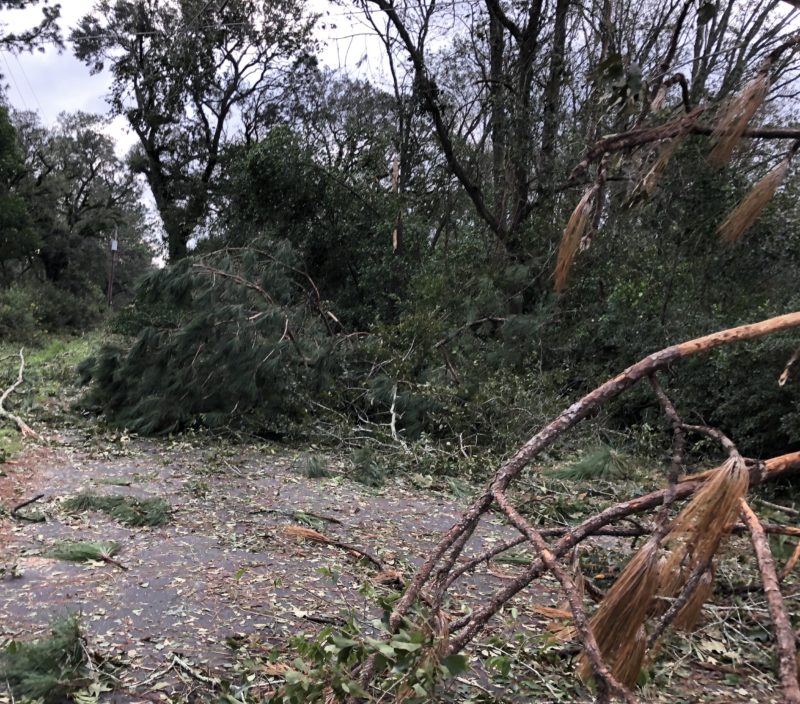
On Thursday afternoon, Bainbridge City Manager Chris Hobby released a detailed explanation and update on the Local, State and Federal governments’ effort to cleanup storm debris left behind by Hurricane Michael. Unfortunately, at the local level, we are stuck in the larger branches of government’s bureaucracy. It seems as though every level of government has done their part to ensure that the remnants of Michael are cleaned up quickly, but when you’re dealing with public funds, procedure often circumvents expediency. While we wait on the Government Accountability Office to vet the procurement process, South Georgians are left with a mess.
The State has contracted with the US Army Corps of Engineers to get the mess cleaned up – and has devoted state resources to alleviate the cost burden that local governments (like the City and County) would normal shoulder. That’s a good thing for us down here. The State is paying 25% of the cost of cleanup and the Federal Government is paying the other 75%. But because some of the pre-approved contractors typically used by the Corps don’t agree with the way the contract was awarded, everything must stop until the GAO in Washington, D.C. can review it all. And right now, we don’t know how long that will take.
In the mean time, Governor Deal has authorized the Georgia DOT to mobilize crews to begin work that the Corps was going to do. The local governments are working hard too – they just don’t have the manpower or money to hire the help it would take to get it done anytime soon. In other words, until the Corps’ contract dispute can be settled, State and Local crews will work and do all they can, but this is going to take a while.
Debris Removal Update #2
Unfortunately, this update does not contain any news that the Corps of Engineers and Ceres Environmental has started work. In fact, we have no idea when that might occur. We know that many of you have questions about this process such as how we got in this situation, what is being done to resolve the impasse and when we might begin to see some progress. The purpose of this message is to tell you what we know and what we think is going to happen.
- How did we get in this situation? Following the devastation of Hurricane Michael it was the immediate duty of local government to clear roadways and to assist other agencies in restoring vital services. This process went very smoothly as debris was quickly removed and roads became passable within a few days of the storm. The city and the county then devoted resources to helping our utility provider partners in gaining access to infrastructure and in guaranteeing that power crews could work in as safe an environment as possible. Despite initial dire warnings that power could be out for weeks or even months; the city saw almost full restoration of power service by Tuesday, October 16 and county residents were largely back on-line within two weeks of the storm.
This moved us to the next phase of the storm recovery which is the removal of storm related debris. In most disaster recovery events, local governments are responsible for coordinating and managing clean-up efforts. The normal process is for the local government to advertise for independent contractors to do the work, to then open bids and award contracts to qualified contractors. This process requires that the local governments be responsible for paying the contractors from available government resources and then to seek reimbursement for the cost of this work from the Federal Emergency Management Agency (FEMA). Normally, this reimbursement covers 75% of the cost of performing the work and the local government is responsible for the remaining 25%.
Following Hurricane Michael, Georgia Governor Nathan Deal and the Georgia Emergency Management Agency (GEMA) quickly realized that the amount of debris to be removed and the cost of this removal was going to be overwhelming to the local governments of Southwest Georgia and the state moved quickly to coordinate a state led solution. Working with FEMA, the state negotiated a contract with the United States Army Corps of Engineers to manage the debris removal in all impacted counties. This arrangement called for the state to cover the 25% local match amount normally required from local governments and essentially insured that the cost of debris removal would not overwhelm the budgets of the cities and counties of Southwest Georgia.
The Corps of Engineers manages disaster relief projects literally all around the world so having them as the states partner seemed to be a good fit. The Corps also maintains a network of pre-qualified debris removal contractors who can be called upon in emergency situations. Unfortunately, this is where our project came off the rails. The Corps elected to award the contract for the Georgia Mission to Ceres Environmental Services over two other pre-qualified contractors. This started a process where the competing contractors have now filed at least four protests alleging that the Corps incorrectly applied federal procurement procedures. Under federal law, these protests must be resolved before any work can begin and the task of resolving the protests is not controlled by the Corps of Engineers but instead by the Government Accountability Office (GAO). The protests that have been filed to date are listed below:
https://www.gao.gov/docket/B-417055.3
https://www.gao.gov/docket/B-417055.4
https://www.gao.gov/docket/B-417055.2
https://www.gao.gov/docket/B-417055.1
- What is being done to resolve the impasse? Everything that can possibly be done is being done. The city and county governments have been in nearly constant contact with state and federal partners. We have had daily contact with representatives of Governor Deal’s office, GEMA has worked to keep all local governments updated on the situation and Senator Dean Burke, Representative Jay Powell and Representative Darlene Taylor have been working diligently on our behalf. U.S Senator Johnny Isakson, U.S Senator David Purdue and U.S Representative Sanford Bishop have all made contact with the Corps of Engineers Headquarters on our behalf and have also reached out to the GAO and to the White House for assistance. The problem is that federal law requires that the GAO evaluate each protest and prohibits work from being done while a protest is unresolved.
The local governments have been reluctant to pull out of the state brokered agreement because we don’t have adequate equipment to complete the debris removal on our own (the city has four trucks) and we don’t have the millions of dollars of needed funds to hire a contractor to do the work even with the promise that we will eventually be reimbursed by FEMA. However, the local governments did today start the process of hiring contractors to complete this work outside of the state agreement. It will be seven days before we can open bids for this work and it is our hope that this will be resolved before that time expires. If the situation is not resolved we are committed to moving ahead with the hiring of private contractors. This will be an extreme burden on the city and county budgets but we feel that we must act if the state and federal government agreement is not resolved.
- When might we see some progress? We have no way of knowing when the bid protest process will be resolved. Governor Deal did today instruct GEMA to begin deploying state resources to impacted counties to begin debris removal. Initially, this will mean that Georgia Department of Transportation employees will be in the community to start the process of removing debris. The first group of state employees should begin arriving tomorrow (Friday, November 2) and they should remain until the Corps of Engineers procurement protests have been resolved.
That is a complete summary of everything we know about the situation. We will keep you updated as things change and we are very hopeful that we will begin to see real progress very soon. In the meantime, please do not hesitate to contact us if you see a situation that presents an immediate danger to vehicles and/or pedestrians.


Be the first to comment